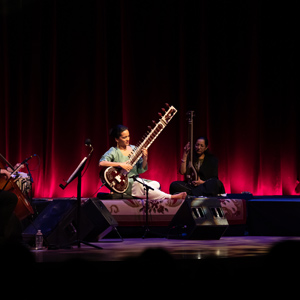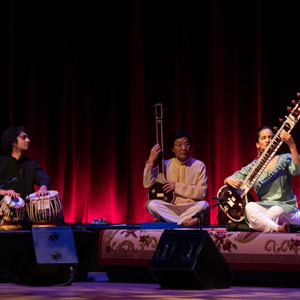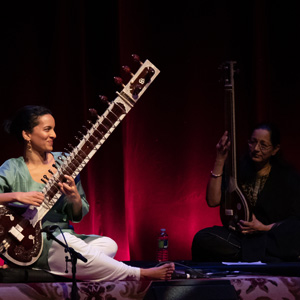Interview: Anoushka Shankar's Romance with the Sitar
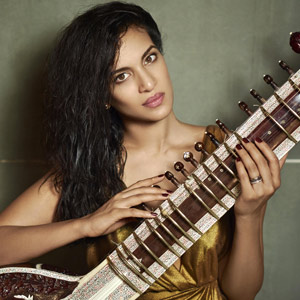
Left: (Photo: Anushka Menon)
The versatile virtuoso talks to Khabar about her collaborations in world music, the evolution of the sitar, and about scoring music for Shiraz, a restored silent film that tells the story behind the construction of the Taj Mahal, and its legend of love and undying devotion.
“Be as I am made, play as I am played.”
That’s a line of prayer often quoted by the contemporary sitar master Anoushka Shankar. While Indian classical is always at the heart of her music, she is also a singular figure in progressive world music, with fusion collaborations across various genres. With multiple albums in a variety of styles, and six Grammy nominations, Shankar is an international artist who embodies the spirit of innovation and experimentation and cross-cultural dialogue in music. Recipient of numerous awards, she performs all over the world with symphonies and with her Indian and world music ensemble.
Shankar, who inherited the unenviable challenge of upholding the legacy of her iconic father, the legendary sitar maestro, Pandit Ravi Shankar, has more than ably proved her mettle by carving out a name for herself as one of the world’s most preeminent sitarists of our times.
Some excerpts from Khabar’s recent interview with Anoushka:
Recently we enjoyed your amazing concert
in Atlanta, where you played beautiful portions
from your first film composition, Shiraz. Can
you share your experience in scoring for this film?
It was my first time scoring a film, so the whole
thing was quite special and I think it was a rare opportunity
to score for a silent film, as you can imagine.
That involved a lot more material and a lot more
work because it required constant music; so it was a
huge output and very ambitious. But it is also an extraordinary
film. It’s a really rare piece of our Indian
cinema history because it’s one of the first pre-sounds
ever made in India. It’s an exquisite record of so many
things to do with Indian culture and Indian history. So
it was really a pleasure to get to work on this film and
help bring it back to life again.
Are there more musical scores of films to come?
I hope so. I very much enjoyed my experience of
doing that, so I would love to do more.
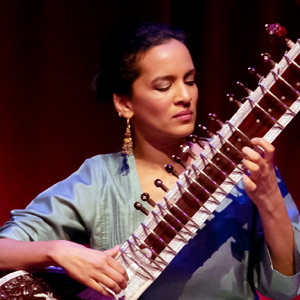
(Photo: Steve Eberhardt)
As you seamlessly integrate different music traditions,
genres, instruments, styles, and artists in
your compositions, is there a common vision that
permeates through these compositions?
It’s been less and less deliberate over the years, and
more a natural, organic process—where it came from
in the beginning around 2005 with my album Rise, for
which I desired to make music freely and to compose
for the first time and to see what would happen. What I
found was that the music I was writing started reflecting
who I am, the person, the kind of life I live, the sort
of multicultural upbringing I had. And the Indian music
that I learnt to play with my father was still at the heart
of it. But it also incorporated all these other elements
like who I am and the kind of music I listen to. And
from there, it’s been a journey of continuing to be curious
about the world, wanting to learn about the world,
making music that represents the kind of connections
that I believe are possible between people when you
find your commonalities rather than your differences.
In your cross-collaboration projects with artists
of different styles and genres including different art
forms, how do you get them to see your vision in the
very first place?
I’ve been very fortunate to work with incredible
musicians across my career. You can’t do collaborations
like this if the people you are collaborating with
aren’t also open and curious and free. I owe a lot to my
collaborators. Sometimes it can be very, very challenging;
sometimes it can be sort of natural. For example,
when I did Traveller, which is a collaboration between
Indian music and flamenco…on the surface, there are
a lot of commonalities—the rhythm, the style of vocal,
the singing, for example. But the approach is totally
different. So I had to find different languages to
explain the music sometimes to the musicians from
different countries and then put it together in a way
that sounded very organic but actually [was] very
challenging to do. But the feeling is incredible
when you find those moments as a result.
Working with a broad spectrum of all
these wonderful musicians can be very
rewarding and tricky; can you share
some of your experiences?
I’ve learnt along the way. I’ve done
scores years ago where rehearsals
would be really stressful and you could
see the musicians getting nervous and
uncomfortable because they were always
being thrown out of their comfort
zone—which can be a good thing
but only to an extent. For example,
when I did my drums sound track last
year. I knew by then to prepare differently
for each musician. The Western
musicians had really good, organized
scores. But I worked with someone to
notate so that they could prepare
scores accordingly. The Indian
musicians had audio cues
where we recorded messages
which would go in
their ear about which
raag they would have to play next. If you had done
the opposite for the other musician, that would
have been so much more stressful. So you have to
do the right thing to the right person—speak in their
language, I guess.
Is there any particular cross-collaboration or concert
of yours that is your personal favorite and why
did that get etched in your memory?
I would think that my most recent extensive tour
for my album Land of Gold feels like my personal best—
putting a lot of my music into a context, and also creating
music that in some ways is quite free of genre and
yet fits on the shoulders of all these beautiful traditions.
I basically worked with an incredible quartet of musicians
and really challenged myself a lot to do things—
like working with a whole pedal setup that guitarists
would use. I’d sit on a chair with my feet at the pedal,
use the delay and all that kind of sound stuff that I’d
never done before. We really designed the sound of
the show to be really, really different. The sitar [came
out] of its known context, and that was something very
exciting for me—because there can be a real association
in people’s subconscious about the sitar and the
kind of image it evokes. For a lot of Western listeners,
as soon as they hear sitar they start thinking of incense
and flying carpets. So it really helped kind of demystify
that idea.
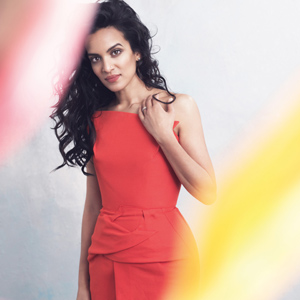
(Photo: ©Yuval Hen / DG, Courtesy: Deutsche Grammophon)
What are the other kinds
of music you listen to,
or other interests that
you have?
I genuinely don’t differentiate
by genre. I listen
to literally all kinds
of music. I love music
and I have a very broad
taste across all kinds
of cultures and styles.
I love art forms,
I love going out to theatre to see plays, to see dance.
Dance is a big passion of mine. Personally I find dance
and plays sometimes more inspiring than music, and
they really move me in my own work.
You bear the legacy of none other than the greatest
institution of sitar—Pandit Ravi Shankar. How has
Panditji’s teaching influenced you to become a composer?
Was he a very strict guru?
He was a very strict
guru, but he also gave an
amazing example in his
own work. I was learning
from him but I was
also growing up around
him. So I got to watch him
work intimately when he
was composing, teaching
other people, coming up
with ideas. That was like
a huge education for me
and I think I was very inspired
by the example of
him, being the level of instrumentalist
he was, and
a creative composer, and
the idea that you could do both of those things.
What were your thoughts behind the inclusion
of ragas Jogeshwari and Pancham se Gara amongst
so many of Panditji’s amazing compositions in
Reflections, your new album?
It was tricky to find the right piece for them because
they are quite different from
everything else. But also, they
are not. For me, those [ragas]
are my roots, they are where
I come from, where everything
started for me. So it
was important to showcase
that as part of the
album that shows the
direction I’ve gone
in since then.
And those two
ragas I love
very dearly,
and played
[them] with
my father
a lot.
There has been a significant evolution of the sitar—the repertoire and the instrument itself. With the
advent of technology, where do you see sitar in the
next 50 years?
Our instruments are so beautiful, but in some
ways it’s great to look for what can be improved. For
example, it’s such a project to keep a sitar in tune for a
prolonged period of time because of the nature of the
pegs and stuff like that.
I am constantly seeking
out people who are trying
to develop things and
make small improvements.
I made a change
about seven years ago
along with Sanjay Sharma
from Rikhi Ram (an
Indian musical instruments
store in Delhi,
India). We built the first
internal microphone for
acoustic sitars, and that
really changed everything
because, you know,
guitars have had that for
decades. They create a more isolated and amplified
sound and that’s really brilliant.
I think one of the beautiful things about our tradition is that it’s always evolved. I don’t think it’s ever stayed locked in any form. That’s the good thing about being an oral tradition and something that has been passed on, generation to generation, and always growing as a result of people’s input over time. I think it will always continue to evolve, and that’s part of what makes it relevant and current.
Do you see any risk for sitar or similar acoustic
Indian classical instruments such as sarod or sarangi
taking a backseat to their digital avatars?
I personally don’t see any risk of that because nothing
replaces acoustic instruments. But I think it’s about
thinking intelligently about what purpose different
forms of music and different instruments serve. One
thing I admire in the West is the space that’s created for
different genres. There’s enough radio stations, there’s
enough TV stations, there’s enough space.… Classical
music has its place, opera has its place, rock has its
place, jazz has its place, electronica has its place, and it
goes on from there. I think that the risk that people feel
in India can be just from a slightly more narrow media
stream. Everyone has to compete against each other
and compete against the juggernaut of Bollywood for
space and I think that is where the problem arises. As
far as music itself goes, in no way do I think there’s the
risk of anything cancelling anything out.
|
|
|
|
|
|
(Left) Moments from Anoushka Shankar’s recent Atlanta performance at the Rialto Center for the Arts at Georgia State University. (Photos: Steve Eberhardt)
What would be your top three picks of your
own compositions?
My favorite picks of my compositions…that’s
difficult. I don’t know. I think so often the recent ones are the ones I feel strongly about. It’s hard to pick out pieces but if I can say albums, then my album Rise means a lot to me. It was my fourth album but in some ways it feels like my first, because it was the first album that I composed and produced myself. So it really was something very dear to me, very precious. I think my recent album, Land of Gold, is another one I feel very proud of because I think it kind of aligned a few different things successfully in that album. It wasn’t just any other album. It was in response to the ongoing refugee crisis, so it connected to what was happening in the world; but also, as a musician, I feel proud of the music as well—all the kind of multicultural and ancient and modern elements in the music. It intersected a lot of different things I care about.
After your very popular Traveller album, is there a music form of another country that has caught your attention and is in the pipeline?
I’m trying to see if I can do something with North African music, for example, or Malian music—I’m very inspired by that. I’m also thinking about traditional
Brazilian music or Cuban music that I would love to
try and find a way to intersect our rhythms and style.
You have been such a strong voice of support for women’s rights, humanitarian and social justice. Are there any new musical projects in your pipeline in support of these causes?
I’m sure. I think I’m very impacted as a person
by what’s going on in the world, and that in turn
impacts my work and my art, and I will continue to align the work I do with my beliefs and the things
that I care about.
Do you plan on teaching the next generation
of sitar players in the immediate future? Do you
teach now?
I have a couple of students who come now and then when I’m living in London. But I don’t have any large class or big group of kids…it’s hard for me to
picture that in the near future because I’m just full. I have my own career and kids. I feel that maybe as I
get older and when I’m able to tour less, then that’s something that I would take on more because, of course, the idea of passing on all of this is so important. And it’s such a key part of how our music continues. I think that’s more in my future rather than in the immediate future.
You are an icon of a modern sitar virtuoso and an inspiration to the next generation of Anoushka Shankars. What is your advice for them?
That’s sweet. I don’t know… I can’t give advice very easily! I guess my only advice is to really find your own voice. Find what you have to give artistically and to
really hone that and protect that and try and bring it
out. Because everyone has something unique to say. And if you’re able to find that, then it will really
resonate with listeners.
Dr. Kakali Bandyopadhyay has served as an affiliate faculty of Sitar and North Indian Classical music at Emory University since 2001, established the North Indian Ensemble at Emory, and has been teaching sitar and Indian music in the Atlanta area. She received her sitar training in India from an early age under world renowned maestros, and later attended master classes with Pandit Ravi Shankar, Ustad Vilayat Khan, and Ustad Ali Akbar Khan.
Enjoyed reading Khabar magazine? Subscribe to Khabar and get a full digital copy of this Indian-American community magazine.
blog comments powered by Disqus




